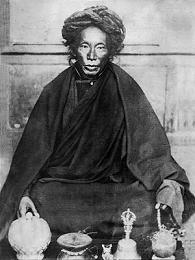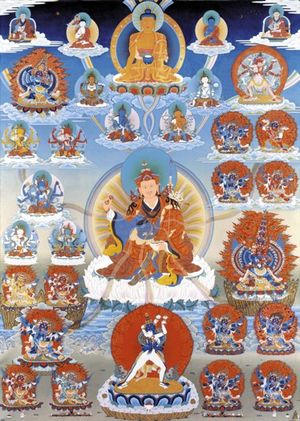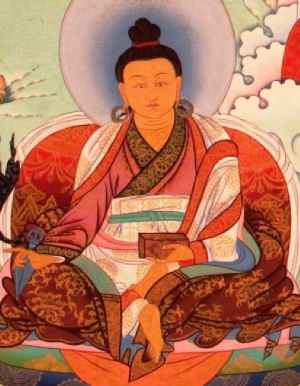Tertön Sogyal

Tertön Sogyal, Lerab Lingpa (Tib. གཏེར་སྟོན་བསོད་རྒྱལ་ལས་རབ་གླིང་པ་, Wyl. gter ston bsod rgyal las rab gling pa) (1856-1926), Sogyal Rinpoche's predecessor, was a prolific tertön and a teacher of the Thirteenth Dalai Lama.
Biography
In his previous incarnations he had appeared as numerous great bodhisattvas and vidyadharas, including the bodhisattva Vajragarbha who compiled the Dzogchen teachings given by the Buddha Samantabhadra in Akanishtha. Later he appeared as Buddha Shakyamuni’s aunt and stepmother, Prajapati Gotami, the founder of the order of nuns, and in Tibet he appeared as Nanam Dorje Dudjom, Trophu Lotsawa and the great Rigdzin Gödemchen (1337-1408), founder of the Northern Treasures (Changter) tradition.
He was born in the year of the Fire Dragon of the fourteenth calendrical cycle (1856) in Upper Nyarong in Kham. His father was Dargye from the Shyipa family and his mother was Orgyen Drolma.
From the age of 13 to 18, he stayed in retreat. During this time he saw many things directly through the power of his clairvoyance. Whilst in retreat, he deciphered a terma in the coded script of Yeshe Tsogyal. After the retreat, he travelled to Kathok with Lama Sonam Thayé and others and received empowerments from Jikmé Yönten Gönpo (aka Tenpé Gyaltsen) and other transmissions from Kathok Getsé Tulku (the reincarnation of Gyurme Tsewang Chokdrup). Later he went to Dzahka Sangak Rabten Ling and received instructions on the preliminaries and main practice of Longsal Nyingpo from Choktrul Rinpoche Kunzang Namgyal. He then went to receive instruction on the Longchen Nyingtik from Patrul Rinpoche’s disciple, Nyoshul Lungtok Tenpé Nyima. Later, he received detailed teachings on the Guhyagarbha Tantra from Mipham Rinpoche for a period of several months.

In the Male Earth Mouse year (1888), he met the Thirteenth Dalai Lama for the first time in Lhasa. They went on to meet several more times, and the Dalai Lama became one of his main students and Dharma heirs. In 1895 he revealed the terma of Yang Nying Pudri together with Jamgön Kongtrul. In time, this Vajrakilaya practice became one of the regular practices of the Dalai Lama’s own monastery, Namgyal, and His Holiness composed a manual for practising it as a drupchen.
He returned to Lhasa several more times in the following years, and travelled widely, revealing more termas including Tendrel Nyesel, Dispelling Flaws in Interdependence, which became one of the most widely practised among his revelations.
In the year of the Wood Mouse (1924) he offered the remainder of his termas to Dodrupchen Jikmé Tenpé Nyima. At the end of their meeting the two masters exchanged white scarves, something they had never done before, and then each said, “I will see you again in the pure land.”
During the Wood Ox (1925), he re-concealed all those termas which remained incomplete and made aspirations to meet with them again in future. Finally, the great tertön displayed the signs of passing into nirvana on the tenth day of the first month of the year of the Fire Tiger (1926).
He was one of the most prolific tertöns in history, his collected terma revelations filling almost twenty volumes. Several of his original written works, most notably his commentary on the Chetsun Nyingtik, have also survived.
His main teachers were Dzatrul Kunzang Namgyal, and Jikmé Yönten Gönpo, the third Trimé Shyingkyong of Katok Monastery. He was also a close student of Nyoshul Lungtok, Jamyang Khyentsé Wangpo, Mipham and Jamgön Kongtrul, and also received teachings from Nyala Pema Dündul and Patrul Rinpoche.
Major Revelations

Tertön Sogyal was a prolific tertön, whose collected revelations and textual rediscoveries (Wyl. gter chos) fill seventeen or twenty volumes, depending on the edition. An index of the seventeen volume edition can be found here.
Some of his more important revelations were:
Writings
Several of his original written works, most notably his commentary on the Chetsün Nyingtik, have also survived.
- Commentary on Chetsün Nyingtik called Wisdom Bindu: A Commentary Summarizing the Heart Essence, Arranged like a Flowing River, on the Quintessence of the Pith Instructions Section of the Great Perfection, the Third Section of the Five Spaces of the King of All Pith Instructions, the Great Chetsün’s Profound Essence of Vimalamitra (Wyl. rdzogs pa chen po man ngag sde'i bcud phur man ngag thams cad kyi rgyal po klong lnga'i yi ge dum bu gsum pa lce btsun chen po'i bi ma la'i zab tig gi bshad khrid chu 'babs su bkod pa snying po'i bcud dril ye shes thig le)
- Trekchö. A Brief Advice on the Practice of Trekchö. (Tib. ཁྲེགས་ཆོད་ཅེས་བྱ་བ་བཞུགས་སོ་, Wyl. khregs chod ces bya ba bzhugs so)
- Key to the Precious Treasury: A Concise Commentary on the General Meaning of the Glorious Secret Essence Tantra, composed by Dodrupchen Jikme Tenpe Nyima. Khenchen Namdrol explained (28 June 2006, Lerab Ling) that this commentary on the Guhyagarbha Tantra has been composed by the combined effort of Dodrupchen Jikme Tenpe Nyima and Lerab Lingpa. Lerab Lingpa requested Dodrupchen to compose it, and helped him at every stage of the writing. Khenchen Namdrol says that this commentary represents the combined expression of these two lamas.
- Special Serkyem Offering to the Protectors of the Terma Teaching of Tertön Sogyal, Lerab Lingpa (རང་ལུགས་ཀྱི་སྲུང་མ་སྤྱིའི་གསེར་སྐྱེམས་, rang lugs kyi srung ma spyi'i gser skyems)
Students
His numerous lineage holders, many of whom were also his own teachers, included the Thirteenth Dalai Lama Thupten Gyatso, Jamgön Kongtrul Rinpoche, the Fifth Dzogchen Rinpoche, Dzogchen Khenpo Pema Vajra, Mipham Rinpoche, Nyoshul Lungtok, Dzahka Choktrul Rinpoche, Tertön Trimé, Kathok Situ Chökyi Gyatso, Minyak Khenpo Kunzang Sonam, Dodrupchen Jikmé Tenpé Nyima, Demo Rinpoche, Dorje Drak Rigdzin Nyamnyi Dorje (1886-1932/5), Minling Trichen Rinpoche, Sakya Trichen, the Fifteenth Karmapa Khakhyap Dorje, Jamyang Khyentse Chökyi Lodrö, Tsultrim Zangpo and his main consort, Khandro Pumo.
His lineage also continued with his sons, including Rigdzin Namgyal and Chöpel Gyatso, and passed on to his grandson, Tromgé Tulku Dechen Dorje, who lives at the Tromgé encampment in eastern Tibet.
Incarnations
He had several incarnations as indicated in the texts of his terma discoveries and in predictions made to his disciples, including Sogyal Rinpoche, who was recognized by Jamyang Khyentse Chökyi Lodrö, and the late Khenpo Jikmé Phuntsok (1933-2004), who received all the transmissions of Tertön Sogyal from Lama Gendun Dargye, a direct disciple of the tertön.
Alternative Names
- Trinlé Tayé Tsal (Tib. འཕྲིན་ལས་མཐའ་ཡས་རྩལ་, Wyl. 'phrin las mtha' yas rtsal)
- Tsa Shul Tulku Sogyal (Tib. རྩ་ཤུལ་སྤྲུལ་སྐུ་བསོད་རྒྱལ་, Wyl. rtsa shul sprul sku bsod rgyal)
- Nyala Sogyal (Tib. ཉག་བླ་བསོད་རྒྱལ་, Wyl. nyag bla bsod rgyal)
Teachings Given to the Rigpa Sangha About Tertön Sogyal
- Nechung Rinpoche, Dzogchen Orgyen Chöling, June 29th 1981
- Nyoshul Khen Rinpoche, Rigpa London, 22 September 1985
- Garje Khamtrul Rinpoche, Lerab Ling, 1992
- Nyoshul Khen Rinpoche, Lerab Ling, 19 October 1996
- Lama Yönten, Rigpa Amsterdam, 6 April 2022
Further Reading
In English
- Nyoshul Khenpo, A Marvelous Garland of Rare Gems: Biographies of Masters of Awareness in the Dzogchen Lineage (Junction City: Padma Publications, 2005), pages 513-514.
- B. Alan Wallace, Open Mind: View and Meditation in the Lineage of Lerab Lingpa (Wisdom Publications, 2018)
In Tibetan
- Tulku Tsultrim Zangpo, gter chen dpa’ bo las rab gling pa phrin las mtha’ yas rtsal gyi rnam par thar pa rmad byung ngo mtshar padma dkar po’i phreng ba
 གཏེར་ཆེན་དཔའ་བོ་ལས་རབ་གླིང་པ་ཕྲིན་ལས་མཐའ་ཡས་རྩལ་གྱི་རྣམ་པར་ཐར་པ་རྣམ་བྱུང་ངོ་མཚར་པདྨ་དཀར་པོའི་ཕྲེང་བ།, gter chen dpa' bo las rab gling pa phrin las mtha' yas rtsal gyi rnam par thar pa rnam byung ngo mtshar pad+ma dkar po'i phreng ba/
གཏེར་ཆེན་དཔའ་བོ་ལས་རབ་གླིང་པ་ཕྲིན་ལས་མཐའ་ཡས་རྩལ་གྱི་རྣམ་པར་ཐར་པ་རྣམ་བྱུང་ངོ་མཚར་པདྨ་དཀར་པོའི་ཕྲེང་བ།, gter chen dpa' bo las rab gling pa phrin las mtha' yas rtsal gyi rnam par thar pa rnam byung ngo mtshar pad+ma dkar po'i phreng ba/
- rgyal ba kaH thog pa’i lo rgyus mdor bsdus
Internal Links
- Longer Biography
- Students of Tertön Sogyal
- Tertön Sogyal's Collected Works